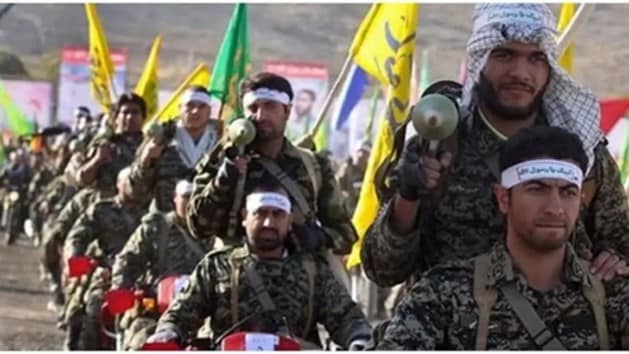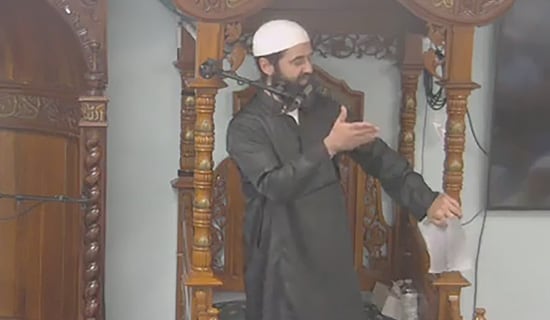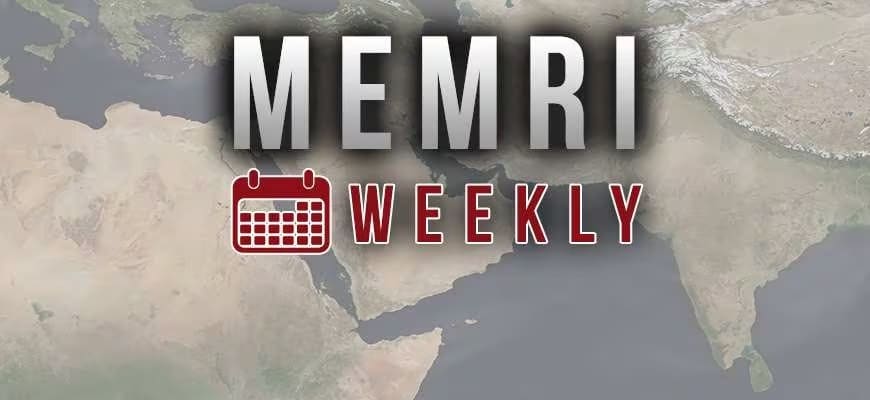The following report is now a complimentary offering from MEMRI's Jihad and Terrorism Threat Monitor (JTTM). For JTTM subscription information, click here.
On January 28, 2024, U.S. Central Command (CENTCOM) announced that three American soldiers had been killed and multiple personnel, at least 34, were wounded in a drone attack on the Tower 22 logistical base in northeastern Jordan, near the Syrian border.[1] U.S. President Joe Biden blamed "radical Iran-backed militant groups operating in Syria and Iraq" for the attack and warned that "we will hold all those responsible to account at a time and in a manner [of] our choosing."[2]
According to Jordanian government spokesman Muhannad Al-Mubaidin the U.S. forces were "cooperating with Jordan in the fight against the terrorist danger and to secure the borders."[3]
Tower 22 is located near the Al-Tanf base in Syria, where U.S. forces are deployed; the base plays a significant role in limiting the establishment of Iranian influence in the region and in fighting the Islamic State (ISIS).
To date, no one has claimed responsibility for the attack, but on the same day, the Islamic Resistance in Iraq, the umbrella organization of several Iran-backed Iraqi Shi'ite militias headed by the Hizbullah Brigades and the Al-Nujaba Movement,[4] claimed that it had carried out three attacks on U.S. bases in Syria, including Al-Tanf and Al-Rukban, near the Jordanian border.[5]
These attacks are part of the escalation in attacks beginning in mid-October 2023 by the Islamic Resistance in Iraq against U.S. bases and forces in Iraq and Syria, which it claims are in response to what it calls the "massacres" Israel is carrying out in the Gaza Strip as part of its war on Hamas that followed Hamas's bloody attack on southern Israel on October 7, 2023, and the U.S. support for Israel.
In response to these attacks, the U.S. has carried out a number of strikes on militia positions in Iraq and Syria, killing several senior officials.[6] However, it appears that this time the U.S. has made it clear that the coming response will be much harsher because of the three dead and many wounded U.S. service members.
In the U.S., fingers were pointed at the Iran-backed Shi'ite militias, particularly the Hizbullah Brigades, as responsible for the attack on Tower 22.[7] President Joe Biden warned that "we will hold all those responsible to account at a time and in a manner [of] our choosing."[8] Two days later, Biden said that he had decided on a U.S. response, and added that the U.S. sees Iran as responsible for the attack since it supplies weapons to the Hizbullah Brigades. However, he stressed, "I don't think we need a wider war in the Middle East."[9] Secretary of State Antony Blinken said, "We will respond, we will respond strongly... at a time and place of our choosing," adding that "that response could be multi-levelled, come in stages, and be sustained over time."[10]
It appears that the U.S. threats and warnings have intimidated Iran and its proxy militias. On January 30, Hizbullah Brigades secretary-general Abu Hussein Al-Hamidawi declared a suspension of military and security operations against the "occupation forces" and "recommended" that the organization's operatives adhere, from now on, to "passive defense" if attacked. Al-Hamidawi sought to absolve Iran from any responsibility, stating that it knows nothing about jihadi activity and that it even opposes escalation against the U.S. forces in Iraq and Syria. He also promised that his organization would continue to defend the Palestinian people in the Gaza Strip "by other means."[11] A Syrian opposition website reported that Iran's IRGC had ordered the militias loyal to it in Syria, and particularly in Deir Al-Zour in the eastern part of the country, to halt their military activity against U.S. bases in Syria.[12]
At the same time, it appears that this response by Iran and its proxy militias is strictly tactical and aimed at preventing an extensive U.S. attack. That is, it does not mean that it is backing down from the strategy implemented by Iran and its proxies in recent years – the main aim of which is attacking U.S. bases in Iraq and Syria in order to force a withdrawal of U.S. troops from the region so as to allow Iran to establish its control there. Throughout these years, MEMRI has published many reports about threats by these elements to attack the U.S. presence in Syria that is preventing Iran and its various proxies from establishing their own presence in the region.
It should be noted that since the establishment in October 2022 of the government of Iraqi Prime Minister Mohammed Shayya' Al-Sudani, which includes political parties from several Iran-backed Shi'ite militias, such as Asa'ib Ahl Al-Haq, the number of attacks on U.S. forces fell significantly in both Iraq and in Syria. This was due to the decision by the militias, that are also members of the government, to suspend military operations against the American forces in order to allow the government to rehabilitate Iraq economically and in its military and security spheres which they hoped would ultimately lead to the departure of the U.S. forces through diplomatic channels.[13] This decision greatly displeased Iran and several of the militias it supports, headed by the Al-Nujaba Movement, all of which viewed it as a betrayal, and they continued to threaten military operations against the American forces.[14]
Thus, it appears that Iran and its proxies viewed the war in Gaza as a pretext for the renewal of attacks against U.S. forces in Iraq and Syria, and the reimplementation of their strategy aimed at forcing the U.S. to withdraw from the region. The Hizbullah Brigades' decision to suspend attacks on U.S. forces, that they claim were being carried out, in this phase, in order to defend and support the Palestinians in the Gaza Strip against what they refer to as Israeli "aggression," even though this "aggression" is ongoing, is additional proof that this is a pretext, and that at the moment of truth, the militias are prioritizing their security over aiding the Palestinians.
It is reasonable to assume that Iran and its proxies will be on the lookout for another opportunity or pretext to renew their attacks on U.S. forces in the region, so as to compel them to withdraw and allow Iran to actualize its aspiration of controlling the region.
This report will focus on the threats to U.S. forces in Syria and the attacks carried out against them in recent years on the orders of Iran and the Syrian regime, as covered in many MEMRI reports:

Iran-backed Shi'ite militias (Source: Alarabiya.net, June 14, 2020)
The Syrian Regime Threatens To Carry Out Military Operations Against U.S. Forces, Urges "Popular Resistance"
The threats and attacks against the U.S. presence in Syria by the Syrian regime and its allies began in mid-2018, after the regime and its allies successfully expelled the Syrian opposition from most of the country, and after ISIS was defeated by the U.S.-led global coalition against it. Senior Syrian regime officials, Syrian state media, and regime affiliates threatened to attack U.S. bases and forces in Syria and encouraged a "popular uprising" against them.
The following are MEMRI reports on this topic:
-
Syrian Regime: We Will Expel U.S. Forces From Syria By Means Of Popular Resistance, March 28, 2018.
-
Syrian Threats Against The U.S. Presence In Syria Continue: U.S. Troops, Bases Are In Our Sights And Will Pay A Heavy Price, May 2, 2018.
-
Assad Regime Calls For Popular Resistance To Expel U.S. Forces From Syria, December 9, 2019.
-
Syrian Establishment Daily: The Stage Of Direct Confrontation With The American Forces In Syria Has Begun, June 26, 2018.
-
Syrian Regime Continues To Encourage Popular Tribal Resistance Against U.S.; Assad: This Is The Only Way To Force The Americans To Leave, October 28, 2020.
In August 2020, the threats escalated, and there were attacks on U.S. bases by regime-affiliated elements. That month, a tribe loyal to the Syrian regime announced the establishment of a tribal army to confront the U.S. presence and the Syrian Democratic Forces. A few days later, another group claimed it had fired rockets at the U.S. base Mission Support Site Conoco, outside Deir Al-Zour. In September 2020, a pro-Syrian regime group released a video threatening to attack the Al-Tanf base.
SUPPORT OUR WORK

The following are MEMRI reports on this topic:
-
Tribe In Deir Al-Zour Loyal To The Syrian Regime Announces Creation Of Tribal Army To Fight The American Presence And SDF, August 10, 2020.
-
Pro-Syrian Regime Group Claims Rocket Attack On U.S. Base In Deir Al-Zour, Threatens To Launch More Attacks, August 19, 2020.
-
Pro-Syrian Regime Group Releases Video Threatening U.S. Base In Al-Tanf; Urges Popular Resistance To U.S. Presence In Syria, September 23, 2020.
Iranian Intentions To Strike U.S. Bases In Syria
In March 2021, Syrian opposition websites began reporting on Iran's intention to strike U.S. interests in Syria in response to U.S. attacks on Iran-backed militias in Iraq and in Syria. According to some reports, these militias, which are deployed in northeastern Syria, then began to deploy missile launchers aimed at U.S. forces in the region.
The following are MEMRI reports on this topic:
-
Syrian Opposition Website: Pro-Iranian Militias In Syria Ready To Respond If U.S. Strikes Again, March 10, 2021.
-
Syrian Opposition Website: Pro-Iranian Militias in Eastern Syria Aim Missiles At American Forces Base In Al-Omar Oilfield, March 15, 2021.
Iran-Backed Militias Attack U.S. Bases
In late June 2021, the Iran-backed militias began carrying out drone and rocket attacks on U.S. bases in Syria by means of previously unknown armed groups which served as a front in an Iranian tactic to distance Iran and the militias which are known to be loyal to it from certain operations so as to avoid direct reprisals. Lebanese Hizbullah-affiliated news outlets and journalists issued threats to attacks the bases U.S. bases in Syria, and Syrian opposition websites reported that the militias were building up their forces in the vicinity of these bases in the northeast of the country, aiming missiles at them and employing drones against them.
The following are MEMRI reports on this topic:
-
Syrian Establishment Daily: The Stage Of Direct Confrontation With The American Forces In Syria Has Begun, June 26, 2018.
-
Syrian Regime Continues To Encourage Popular Tribal Resistance Against U.S.; Assad: This Is The Only Way To Force The Americans To Leave, October 28, 2020.
-
Article In Pro-Hizbullah Daily: Violence Against U.S. Forces In Eastern Syria Is Likely To Increase, With Attacks On Patrols, Supply Convoys, July 16, 2021.
-
Attack On Al-Tanf Base By Resistance Axis Forces– A Turning Point In Axis Efforts To Expel U.S. Troops From Syria, October 21, 2021.
-
'Allies Of Syria Operations Room' – A Tool For The Implementation Of Plans Of The Iran-Led Axis Of Resistance, To Expel American Forces From Syria, November 11, 2021.
-
Syrian Opposition Website: Iran-Backed Abu Al-Fadl Al-'Abbas Militia Was Behind Rocket Attack On Coalition Base In Al-Omar Oilfield, Syria, August 17, 2022.
-
Articles In Hizbullah-Affiliated Media: Response To Attacks By Israel In Syria Will Be Attacks On U.S. Forces; Popular Resistance To These Forces Should Be Increased, October 25, 2022.
-
Syrian Opposition Website: Iranian Militias Transport Medium and Long-Range Missiles To Fortified Area Near U.S. Forces At Al-Tanf Garrison In Syria, January 4, 2022.
-
Syrian Opposition Website: Hizbullah Intends To Launch Drone Attack On Al-Tanf Area Where U.S. Forces Are Stationed, June 28, 2022
-
Syrian Opposition Website: Iran's Revolutionary Guards Corps, Iran-Backed Militias In Syria Preparing For Military Strike, Possibly Against Al-Tanf Base, Housing U.S. Forces, September 19, 2022.
Beginning in January 2023, Iran-backed Iraqi militias began claiming responsibility for attacks on U.S. bases in Syria, as Lebanese Hizbullah-affiliated news outlets and Syrian opposition websites continued to report on these militias' intentions to attack these forces.
The following are MEMRI reports on this topic:
-
Iran-Backed Militia In Iraq Claims Responsibility For Missile Attack On U.S. Military Base In Syria, January 4, 2023.
-
Iran-Backed Iraqi Militia Claims Responsibility For Drone Attack Against U.S. Al-Tanf Base In Syria, January 22, 2023.
-
Iran-Backed Iraqi Militia Releases Footage Of Launching Three Drone Attack On U.S. Base In Syria, January 25, 2023.
-
Iran-Backed Liwa' Al-Ghaliboun Releases Footage Of Launching March 23 Drone Attack On U.S. Forces In Syria, March 27, 2023.
-
Pro-Hizbullah Lebanese Daily: An American Attack In Eastern Syria Will Be Met With An Axis Of Resistance Attack On The U.S. Al-Tanf Garrison, August 3, 2023.
-
Syrian Opposition Website: Iran's Revolutionary Guards Corps, Iran-Backed Militias In Syria Preparing For Military Strike, Possibly Against Al-Tanf Base, Housing U.S. Forces, September 19, 2022
[1] Centcom.mil/MEDIA/PRESS-RELEASES/Press-Release-View/Article/3658552/update-us-casualties-in-northeast-jordan-near-syrian-border, January 28, 2024.
[2] Whitehouse.gov/briefing-room/statements-releases/2024/01/28/statement-from-president-joe-biden-on-attack-on-u-s-service-members-in-northeastern-jordan-near-the-syria-border/, January 28, 2024.
[3] Alghad.com, January 28, 2024.
[4] On the Islamic Resistance in Iraq, see MEMRI JTTM report Iran-Backed Iraqi Militias Attack Three U.S. Bases In Eastern Syria; 'Al-Akhbar' Daily: Possibility Of Ground Attack Against U.S. Forces, December 18, 2023.
[5] T.me/elamharbi/262, January 28, 2024.
[6] For example, on January 4 and 24, 2024 the U.S. carried out attacks on positions and weapons depots of militias in Iraq.
[7] Defense.gov/News/News-Stories/Article/Article/3659809/3-us-service-members-killed-others-injured-in-jordan-following-drone-attack/, January 29, 2024.
[8] Whitehouse.gov/briefing-room/statements-releases/2024/01/28/statement-from-president-joe-biden-on-attack-on-u-s-service-members-in-northeastern-jordan-near-the-syria-border, January 28, 2024.
[9] Cnn.com/2024/01/30/politics/biden-jordan-attack-response/index.html, January 30, 2024.
[10] Theguardian.com/us-news/2024/jan/30/biden-says-he-has-decided-us-response-to-jordan-drone-attack, January 30, 2024.
[11] See MEMRI JTTM report Iran-Backed Hizbullah Brigades In Iraq Announce Suspension Of All Operations Against U.S. Forces, Denies Iran's Involvement In Previous Attacks, Says Teheran Often Advised Against Escalation, January 30, 2024.
[12] Syriahr.com, January 31, 2024.
[13] For more on this ceasefire, see MEMRI JTTM reports Iraqi Resistance Coordination Committee (IRCC): We’ve Halted Attacks On U.S. Forces; “Last Chance” For Government To Expel Them, June 26, 2023 and Head Of Iran-Backed Asa'ib Ahl Al-Haq: Resistance Ceasefire With U.S. Forces Stabilized Iraq, U.S. Plan To 'Spread Homosexuality' Grave Danger That Must Be Combatted, June 29, 2023.
[14] See for example MEMRI JTTM Reports: Iran-Backed Iraqi Militia Ashab Al-Kahf Threatens To Expel Americans If They Target Any Jihadi Leader, Announces Upcoming New Resistance 'Project' To Protect Iraq's Sovereignty, End 'Recruitment Of Mercenaries', June 5, 2023; Two New Iraqi Shi'ite Groups Vow To Launch 'Qualitative Operations' Targeting U.S. 'Occupation', Accuse Al-Sudani Government Of Betrayal For Not Expelling U.S. Forces, June 4, 2023; Iran-Backed Shi'ite Militias In Iraq Respond To U.S. Ambassador's Call To Disarm Them: American She-Satan Must Be Silenced; Only Solution Is "The Weapons Of The Resistance;" Shi'ite Forces In Government Neglecting Obligation To Take Revenge Against U.S., May 17, 2023; Spokesman Of Iraq's Iran-Backed Al-Nujaba Movement: Resistance Will Fight U.S. Until It Withdraws From Iraq, Target U.S. Bases In Neighboring Countries, Send Weapons And Men To Fight Israel, May 4, 2023; and Iran-Backed Al-Nujaba Movement: U.S. Will Remain An Enemy Of Iraq Even If It Withdraws; We Must Exact Revenge; Oppose Any American Presence, May 2, 2023.




